-
- Trading Platforms
- PU Prime App
- MetaTrader 5
- MetaTrader 4
- PU Copy Trading
- Web Trader
- PU Social
-
- Trading Conditions
- Account Types
- Spreads, Costs & Swaps
- Deposits & Withdrawals
- Fee & Charges
- Trading Hours
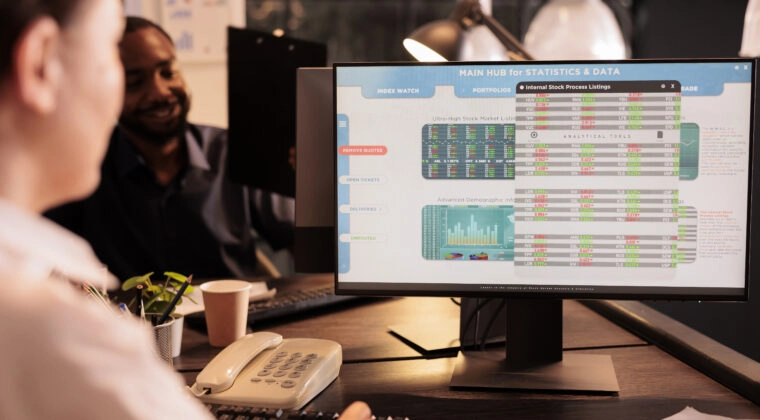
Entering the world of financial trading can be as thrilling as it is challenging, with Contracts for Difference (CFD) offering a gateway to the volatile markets. Yet, even the most experienced CFD traders can sometimes find themselves stumbling through the same pitfalls. Is it a lack of knowledge, overconfidence, or just bad luck? The truth might surprise you. In this comprehensive guide, we’ll steer you clear of the common mistakes in trading and outline the best practices to trade CFD with confidence and success.
* Understanding the common pitfalls in CFD trading to avoid repeating costly mistakes.
* Importance of integrating robust risk management techniques to safeguard your trades.
* Executing trades with a well-thought-out plan rather than relying on hunches.
* Controlling emotions to maintain focus on long-term trading strategies.
* Recognition of overleveraging symptoms and strategies to prevent it.
* Awareness of the consequences of overtrading and methods to overcome the urge.
As financial markets evolve, CFD trading continues to gain momentum among traders seeking flexible investment options. Before diving into this dynamic market, it’s crucial to grasp the fundamental aspects of CFDs and their unique position within the trading landscape.
Contracts for Difference (CFDs) are sophisticated trading instruments that allow an individual to speculate on the rising or falling prices of fast-moving global financial markets or instruments. Unlike traditional investing, CFD trading doesn’t involve actually owning the underlying asset; it’s more about leveraging the asset’s price movements. This characteristic makes CFDs a versatile tool for traders.
Understand What Is CFD Trading And How It Works
Find out more here

When you trade with a CFD broker, you enter into an agreement to exchange the difference in the value of an asset from the point at which the contract is opened to when it is closed. With CFD trading, you can trade on margin, providing the flexibility to go long (buy) if you think market prices will rise, or go short (sell) if you anticipate they will fall.
How does a CFD trading platform fit into this equation? These platforms are the gateway to the markets – they’re applications provided by CFD brokers that allow traders to execute orders, view market data, and conduct analysis in real-time. They’re an essential tool for anyone involved in CFD trading. Selecting a reputable CFD broker is pivotal, as a broker’s reliability, fee structure, trading platform, and customer support can significantly impact your trading experience and performance.
Understand How To Choose The Best CFD Broker
Find out more here

One of the most enticing yet perilous aspects of CFD trading is the ability to leverage investments. Many CFD traders have fallen into the trap of overleveraging transactions, seduced by the potential of significant returns. Overleveraging means committing a large portion of capital to trades using borrowed money, which amplifies both gains and losses.
Recognizing the hazards associated with overleveraged trades is vital. It can lead to a quick depletion of your trading account if the market moves against you.
To circumvent overleveraging, it is important for individuals who trade CFD to keep a meticulous record of their leverage use and to adhere to a disciplined trading strategy that includes leveraging limits. By doing so, traders establish a safeguard against the volatility of the market.
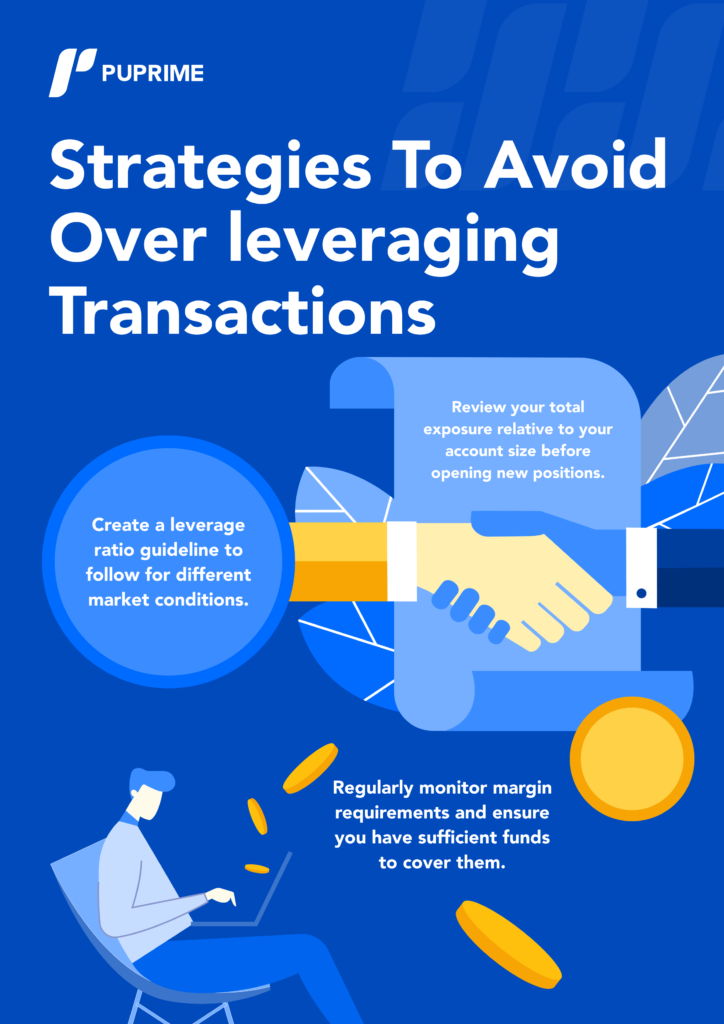
In conclusion, while leverage is a powerful tool for a CFD trader, it must be used judiciously. Overleveraging transactions can result in dramatic losses, and therefore, it is crucial to implement strict leverage management practices to preserve capital and sustain long-term trading activities.
Practise Leveraged Trading With A Free Demo Account
Create demo account

For a CFD trader, overlooking the implementation of risk management strategies stands out as one of the pivotal mistakes in trading. Demonstrated through the highs and lows of market conditions, trade CFD actions are earmarked by uncertainty. Addressing this uncertainty demands a meticulous approach to managing potential risks. Not engaging in such practices not only magnifies the likelihood of significant losses but stunts the growth of a trader’s skill set and portfolio balance. Below we delve into the key tenets of risk management that traders should integrate into their strategies.
1. Setting Stop-Loss Orders: A cornerstone of risk management, stop-loss orders serve as a safety net, automatically closing a trade when it hits a predefined loss threshold, thereby preventing further financial haemorrhage.
2. Diversifying the Trading Portfolio: To spread risk and minimise the impact of a failing position, diversification across various asset classes is crucial, acting as a buffer against market volatility.
3. Managing Position Sizes: Prudent position sizing ensures that a trader is not overexposed in a single trade; a practice that keeps potential losses within manageable boundaries, a testament to informed trading decisions.
Below is a table that compares effective and ineffective risk management practices:
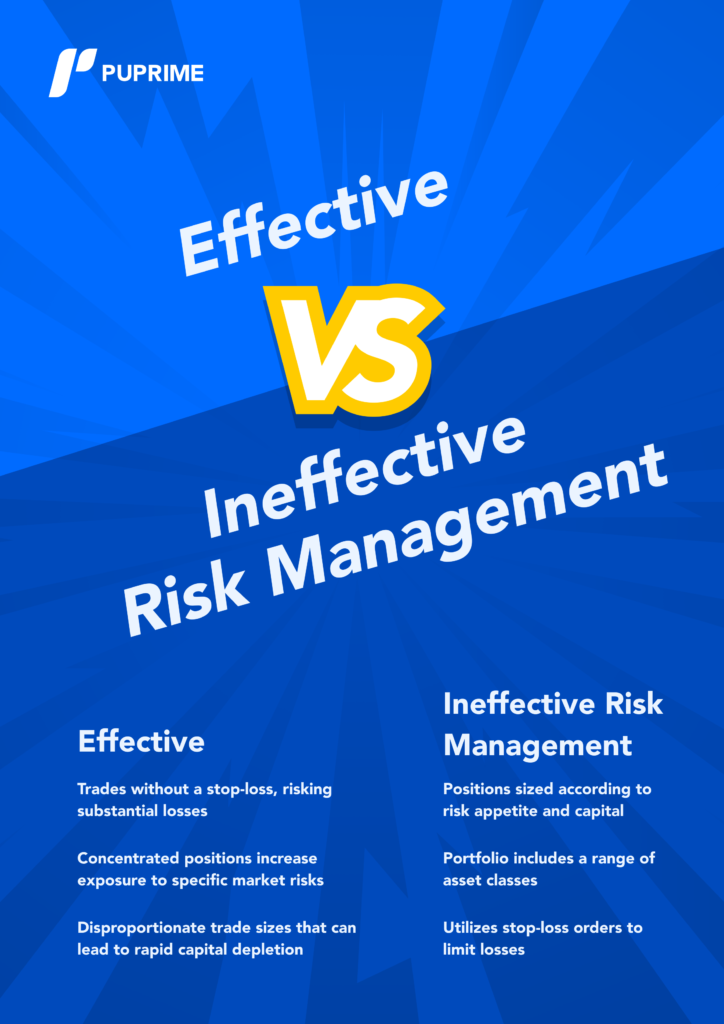
Remember, mitigating risks is not about avoiding them but about understanding and managing them to navigate the markets with discipline and foresight.
Risk Management Strategies Are Crucial In CFD Trading
Find out more

Embarking on the journey of a CFD trader without a robust CFD trading plan is akin to navigating a ship in stormy seas without a compass. Such a plan serves as a framework that not only guides traders through the fluctuations of the market but also provides a structured approach to trade CFD with intentionality and precision. In the absence of such a plan, traders are often swayed by market noise, leading to erratic decisions that could jeopardise their trading accounts.
One of the fundamental reasons a well-crafted CFD trading plan is indispensable lies in its ability to help a trader establish clear, achievable goals. These objectives act as beacons, ensuring that every action taken is a step towards the desired outcome. Moreover, a trading plan empowers the CFD trader with a sense of discipline, enabling them to execute trades based on predefined criteria rather than impulsive reactions to market movements.
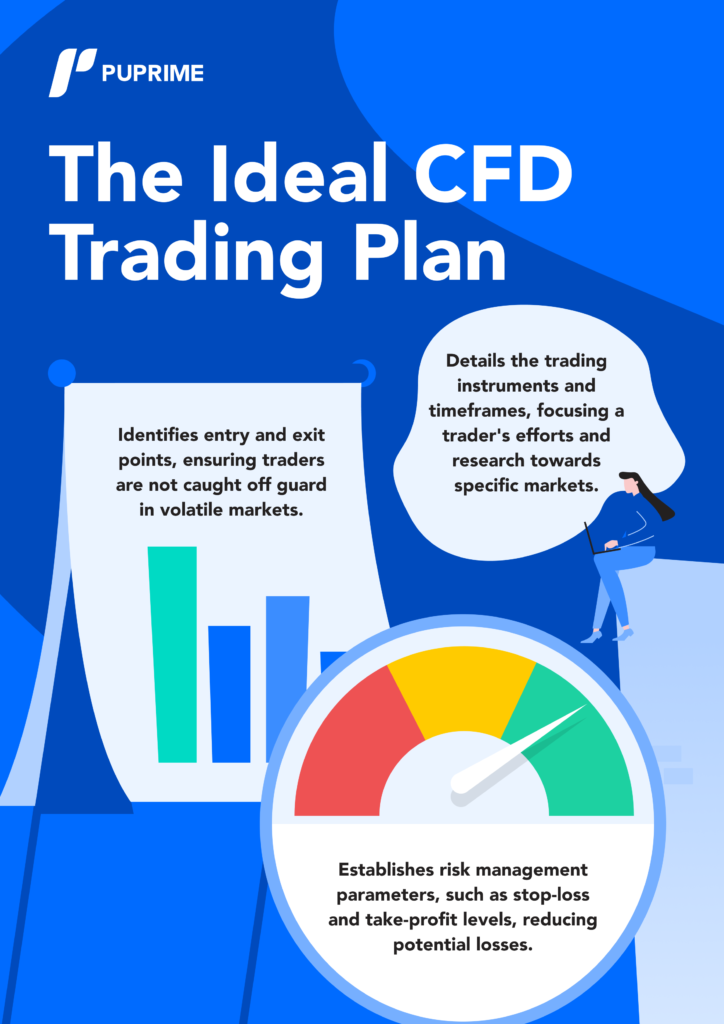
While developing a trading plan, CFD traders must consider both technical and fundamental analysis to form a comprehensive strategy that resonates with their trading style and risk tolerance. It is not enough to merely create a plan; the success of a CFD trader hinges on their consistency in adhering to it, irrespective of the emotional highs and lows that come with trade CFD.
The CFD trading plan is a vital navigational tool that plots a course through the turbulent waters of the financial markets. It encapsulates the trader’s methodology, risk assessment and personal goals into a coherent, strategized approach.
Ultimately, a CFD trading plan is more than just a spreadsheet or a set of rules; it is a personal commitment to professional conduct in trading, a CFD trader’s solemn promise to themselves to operate within a structured, methodical framework that maximises their potential for success while minimising unnecessary risk.
Check Out Some CFD Trading Strategies
Find out more

Every seasoned CFD trader understands that trading decisions influenced by emotions can drastically undermine the success of their portfolio. Emotions such as fear and greed are often the culprits behind impulsive trading behavior. Strategies are key to overcoming this psychological challenge and ensuring that when you trade CFD, you’re guided by logic and discipline rather than transient feelings.
Controlling emotions starts with awareness and is fortified by structured approaches to trading. Below are several strategies to ensure that allowing emotions affect trading decisions becomes a notion of the past:
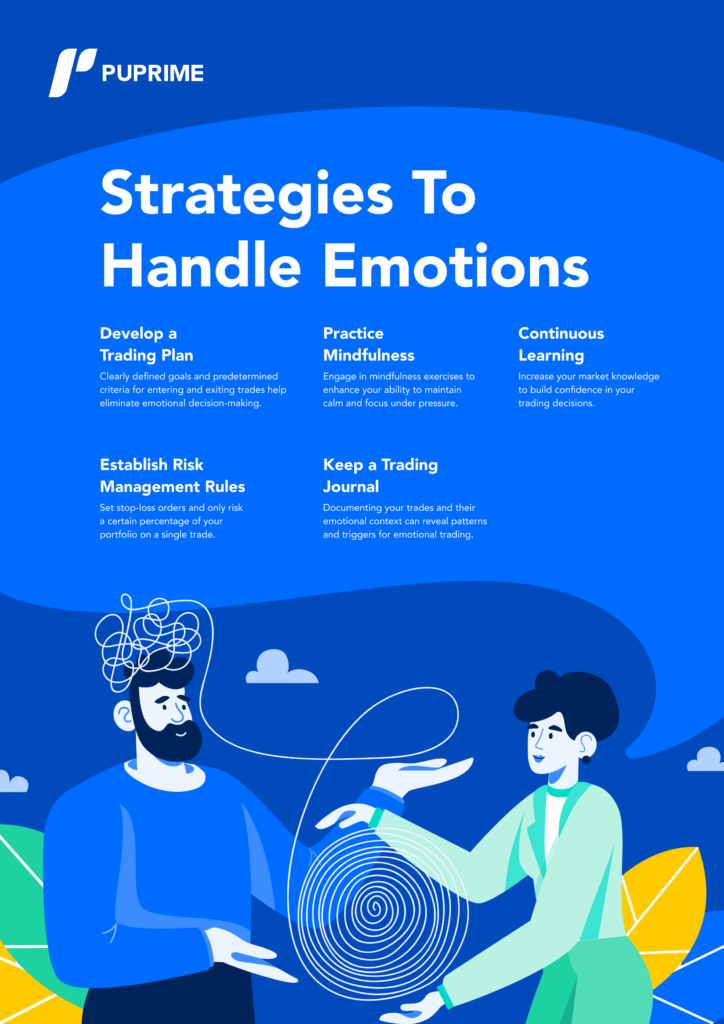
By tackling the emotional side of trading head-on, CFD traders can improve their decision-making process and, in turn, their potential for profitability. Remember, the market does not react to emotions, so neither should you.
Overtrading is a prevalent issue among those who trade CFD, and it stands as one of the significant mistakes in trading that can affect a CFD trader’s performance adversely. This behavior can be characterized by an excessive number of trades, often driven by emotional responses rather than thoughtful strategy. A common misconception is that more trades can equal more opportunities for profit; however, this is often not the case.
The urge to overtrade may strike when a trader either attempts to recover losses quickly or when they sense a false moment of invincibility after a win. In both scenarios, the focus shifts from calculated decisions to the quantity of trades, inadvertently increasing transaction costs and the potential for greater losses. Recognizing the signs of overtrading is key to maintaining a disciplined approach in the volatile world of CFDs.
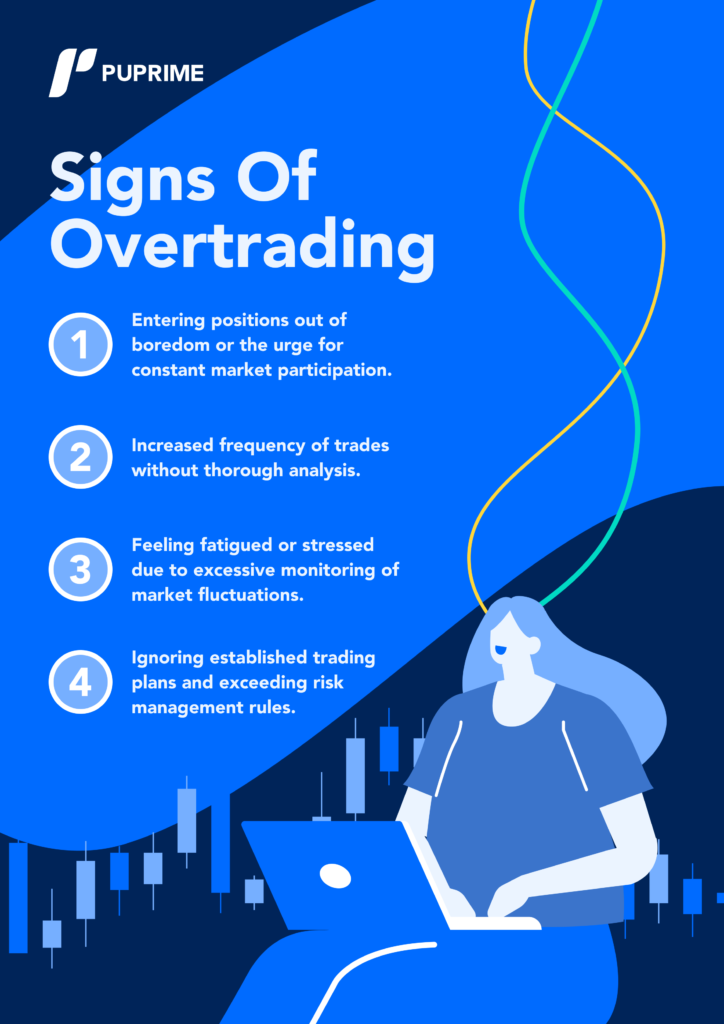
To prevent overtrading, emphasis should be placed on quality over quantity. A CFD trader must adhere to a robust trading plan, set realistic goals for each session, and establish stringent risk management protocols. The essence of successful CFD trading is not in the volume of trades executed but in the precision and thoughtfulness of each decision made.
Patience and discipline are more valuable than the rush of frequent trading. A single well-planned trade can be more profitable than numerous unplanned ones.
By understanding and addressing the motives behind overtrading, a trader can streamline their approach, focus on their long-term objectives, and trade CFD more effectively. Remember, reducing the incidence of overtrading is not just about avoiding a mistake; it is about cultivating a sustainable and strategic trading mindset.
As we culminate our journey through the intricate world of CFD trading, it’s paramount for every CFD trader to internalize the lessons shared within this article. Grasping the common mistakes and embodying the strategies to avoid them is essential for those seeking proficiency in how to trade CFD effectively.
In essence, the journey of a CFD trader is one of constant learning and adaptation. By arming yourself with knowledge, persistently refining your strategies, and leveraging the capabilities provided by top-tier CFD brokers, you cultivate a competitive edge in the pursuit of trading excellence. Remain vigilant, educated, and strategic in your approach to trading CFD, and the markets may prove to be a realm of great potential and opportunity.
Open A Live Account And Start Trading
Create live account

CFD trading can be challenging due to its complexity and the inherent risks involved. Unlike traditional investing, CFD trading involves leverage, which amplifies both gains and losses. Additionally, market volatility and unpredictable price movements can make it difficult to predict outcomes accurately. Successful CFD trading requires a deep understanding of financial markets, risk management techniques, and continuous monitoring of market conditions.
CFD traders can earn profits by speculating on the price movements of various financial assets, including stocks, commodities, currencies, and indices. They can profit from both rising and falling markets by buying (going long) or selling (going short) CFD contracts. The key to earning profits lies in accurately predicting price movements and executing well-timed trades. Effective risk management strategies, such as setting stop-loss orders and managing leverage responsibly, are also crucial for long-term success.
The volatility of CFDs can vary depending on the underlying asset and prevailing market conditions. Generally, volatile assets such as certain currency pairs, commodities like oil or gold, and individual stocks of high-growth companies tend to exhibit greater price fluctuations, making them attractive for traders seeking opportunities to profit from rapid price movements. However, it’s essential to remember that higher volatility also entails increased risk, so traders should conduct thorough research and employ risk management measures accordingly.
While many CFD brokers are reputable and regulated by financial authorities, the safety of CFD trading platforms can vary. It’s crucial for traders to conduct due diligence before choosing a broker, ensuring they are licensed, regulated, and have a track record of reliability and integrity. Traders should also consider factors such as the broker’s reputation, customer service quality, trading fees, and the range of assets and trading tools offered. Additionally, it’s advisable to start with a demo account to test the platform’s features and functionalities before committing real funds.
Developing a successful CFD trading strategy requires a combination of research, analysis, and practical experience. Start by defining your financial goals, risk tolerance, and preferred trading style (e.g., day trading, swing trading, or position trading). Conduct thorough market research and analysis to identify potential trading opportunities based on technical indicators, fundamental analysis, and market sentiment. Backtest your trading strategy using historical data to evaluate its effectiveness and refine it as needed. Additionally, continuously monitor market conditions, adapt to changing trends, and remain disciplined in executing your strategy while managing risks effectively. Seeking guidance from experienced traders or investing in educational resources can also help enhance your skills and knowledge in CFD trading.
Step into the world of trading with confidence today. Open a free PU Prime live CFD trading account now to experience real-time market action, or refine your strategies risk-free with our demo account.
This content is for educational and informational purposes only and should not be considered investment advice, a personal recommendation, or an offer to buy or sell any financial instruments.
This material has been prepared without considering any individual investment objectives, financial situations. Any references to past performance of a financial instrument, index, or investment product are not indicative of future results.
PU Prime makes no representation as to the accuracy or completeness of this content and accepts no liability for any loss or damage arising from reliance on the information provided. Trading involves risk, and you should carefully consider your investment objectives and risk tolerance before making any trading decisions. Never invest more than you can afford to lose.

Trade forex, indices, metal, and more at industry-low spreads and lightning-fast execution.
Sign up for a PU Prime Live Account with our hassle-free process.
Effortlessly fund your account with a wide range of channels and accepted currencies.
Access hundreds of instruments under market-leading trading conditions.
Please note the Website is intended for individuals residing in jurisdictions where accessing the Website is permitted by law.
Please note that PU Prime and its affiliated entities are neither established nor operating in your home jurisdiction.
By clicking the "Acknowledge" button, you confirm that you are entering this website solely based on your initiative and not as a result of any specific marketing outreach. You wish to obtain information from this website which is provided on reverse solicitation in accordance with the laws of your home jurisdiction.
Thank You for Your Acknowledgement!
Ten en cuenta que el sitio web está destinado a personas que residen en jurisdicciones donde el acceso al sitio web está permitido por la ley.
Ten en cuenta que PU Prime y sus entidades afiliadas no están establecidas ni operan en tu jurisdicción de origen.
Al hacer clic en el botón "Aceptar", confirmas que estás ingresando a este sitio web por tu propia iniciativa y no como resultado de ningún esfuerzo de marketing específico. Deseas obtener información de este sitio web que se proporciona mediante solicitud inversa de acuerdo con las leyes de tu jurisdicción de origen.
Thank You for Your Acknowledgement!